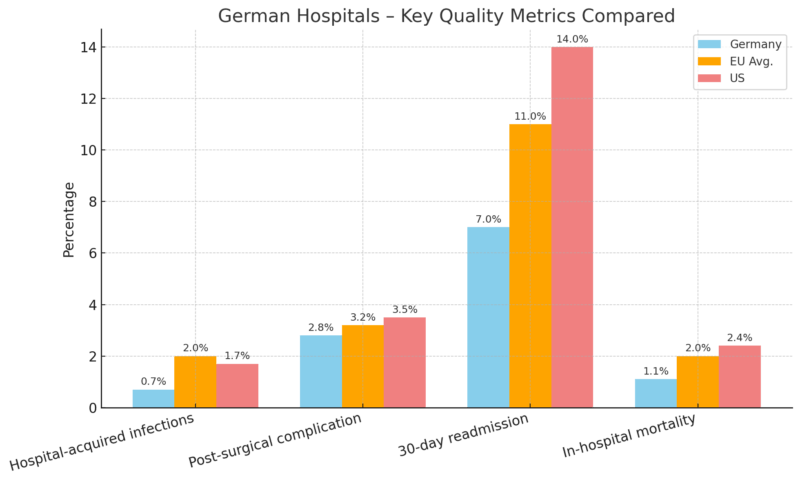German hospitals are considered the global benchmark for advanced healthcare due to their combination of world-class medical expertise, cutting-edge technology, stringent quality standards, high patient safety, and seamless integration between public and private sectors.
This reputation is not just a matter of prestige—it’s supported by hard numbers: Germany spends about 12.7% of its GDP on healthcare according to WHO, hosts over 1,900 hospitals, and is among the top five countries globally for both medical innovation and patient outcomes.
These institutions consistently lead in transplant success rates, cancer survival, and low rates of preventable complications, setting a bar few others match.
Factor
German Hospitals
Global Comparison
Technology
Cutting-edge, universal
Patchy (varies by nation)
Staff qualification
High, continuous
Mixed
Universal access
Yes
Often limited
Infection control
Among the world’s best
Mixed
Outcome transparency
Mandatory
Rare outside the EU
Research integration
Extensive
Limited in most nations
Patient satisfaction
High
Mixed
Table of Contents
ToggleThe German Hospital System: Scale and Structure
Germany’s healthcare landscape is one of the most robust and accessible in the world. As of 2024:
- Number of Hospitals: 1,903
- Hospital Beds per 1,000 People: 7.8 (OECD average: 4.4)
- Annual Admissions: Over 18 million
- ICU Beds per 100,000 People: 34 (OECD average: 12)
- Healthcare Workforce: 2.2 million (doctors, nurses, allied health professionals)
- Average Length of Stay: 7.2 days (one of the highest in Europe)
Metric
Germany
OECD Avg.
US
UK
Japan
Hospitals (total)
1,903
—
~6,100
~1,200
~8,300
Hospital beds / 1,000 people
7.8
4.4
2.9
2.4
12.6
ICU beds / 100k people
34
12
29
7
14
Healthcare spending (% GDP)
12.7%
9.7%
16.6%
11.9%
11.0%
Physicians / 1,000 people
4.6
3.7
2.7
3.0
2.6
Average length of hospital stay
7.2 days
6.6 days
4.7 days
5.0 days
16.2 days
Patient satisfaction (%)
84%
—
76%
72%
81%
Medical Excellence and Innovation

German hospitals are staffed by physicians who undergo some of the most rigorous training in the world. Specialization is a point of pride—over 70% of German hospital doctors are board-certified in at least one specialty, and many in two or more.
Germany is a recognized leader in organ transplantation, cardiology, oncology, and minimally invasive surgery.
Concrete Achievements
- Organ transplant survival rates: Among the highest in the world; 1-year kidney transplant survival >95%.
- Cancer care: 5-year breast cancer survival rate: 87% (vs. EU avg. 83%).
- Cardiac surgery: Over 100,000 open-heart procedures annually; mortality rates below 2% for elective surgery.
- Medical patents: Germany files over 12,000 medical technology patents per year, second only to the US globally, according to MD Tech Europe.
Key Innovations
Quality Assurance and Accreditation
One of the biggest reasons German hospitals are held as a benchmark is their relentless pursuit of quality.
- Accreditation: Silamed notes that 90% of hospitals are voluntarily accredited by independent agencies (such as KTQ, JCI, DIN EN ISO).
- Complication rates: Hospital-acquired infection rates are among the lowest in Europe (0.7% vs. 2.0% EU avg).
- Patient safety: Every major hospital has a dedicated risk management team and publishes annual quality reports online.
Key Quality Metrics

Technology, Facilities, and Patient Experience
German hospitals today are synonymous with technological excellence and patient-centric care, establishing an environment where medical innovation and patient comfort go hand in hand.
Every regional hospital in Germany is equipped with advanced diagnostic imaging technology, such as real-time MRI, CT, and digital X-ray systems. These tools are not only standard but are often the very latest generation, enabling precise and rapid diagnoses regardless of whether the patient is in a city clinic or a rural hospital.
University medical centers take this even further, frequently offering state-of-the-art PET-CT scanning for advanced cancer detection, as well as hybrid operating rooms that combine imaging and surgery for the most complex cases.
Since 2022, the use of artificial intelligence in diagnostics has expanded rapidly across Germany. Many hospitals now employ AI-driven systems to support radiology, oncology, and pathology, significantly improving diagnostic accuracy and helping clinicians spot subtle signs of disease that might be missed by the human eye alone, according to NCBI.
This embrace of AI is not just about the technology itself—it reflects a wider commitment to integrating new medical breakthroughs into everyday practice, ensuring German patients benefit from the latest advances in global healthcare.
Surgical technology is equally advanced. Over 350 hospitals in Germany perform robotic-assisted surgeries each year, placing the country among the global leaders in the adoption of robotics for minimally invasive procedures, according to some studies.
These systems enable higher precision, smaller incisions, and quicker recoveries, reducing both complications and hospital stays.
Patient experience in German hospitals is the product of deliberate policy and ongoing investment. National surveys consistently show that 84% of patients are satisfied with their hospital stay, one of the highest rates anywhere in Europe.
This is partly due to the environment: more than 60% of hospital rooms are designed for one or two patients, offering a high degree of privacy, infection control, and comfort.
Digital transformation is another key factor. Most universities and large city hospitals now offer patient portals where individuals can view test results, communicate with their care team, and access telehealth appointments.
These technologies were scaled up significantly during the pandemic and have become a permanent feature of the modern German healthcare experience.
Accessibility and Integration
One of the most fundamental reasons German hospitals are seen as a global benchmark is their universal accessibility, a feature built into the very structure of the country’s healthcare system.
Germany’s statutory health insurance model ensures that every legal resident—regardless of income, age, or employment status—has access to comprehensive hospital care. As noted by NCBI, more than 99.7% of the population is covered, making barriers to care virtually nonexistent for citizens and permanent residents alike.
The cost to patients is remarkably low compared to most developed countries. The average inpatient co-payment is €10 per day and is capped at a maximum of 28 days per year, even for those requiring lengthy or repeated hospitalizations.
Out-of-pocket payments account for only about 12% of total health spending in Germany, a figure that stands in stark contrast to the United States, where the share is more than double. This financial structure is specifically designed to remove the risk that health costs could bankrupt a family—a problem that remains widespread in other countries.

German hospitals also serve as a hub for international medical care. In 2023 alone, more than 250,000 foreign patients traveled to Germany for treatment, attracted by the high level of medical expertise, cutting-edge technology, and the availability of complex procedures in specialties such as surgery, oncology, and orthopedics, according to UNICLINICS.
This robust medical tourism sector underlines the global reputation of German hospitals as destinations for the most challenging cases.
Integration and continuity of care are priorities embedded into the national system. Patients benefit from seamless communication between family physicians, specialists, and hospital teams. Electronic health records are increasingly standardized, allowing for rapid information sharing and coordinated care.
As a result, German patients experience smooth transitions at every step, from outpatient consultation to inpatient treatment and post-discharge follow-up, minimizing the risks associated with fragmented healthcare.
A comparison of patient access metrics demonstrates the strengths of the German approach:
Access Indicator
Germany
United States
United Kingdom
France
Universal coverage
Yes
No
Yes
Yes
Average ER wait (urgent cases)
22 mins
58 mins
45 mins
28 mins
Out-of-pocket as % of health cost
12%
28%
16%
10%
Foreign patients per year
250,000+
~50,000
~25,000
~80,000
Germany’s universal coverage, efficient emergency response, low out-of-pocket spending, and its ability to attract hundreds of thousands of international patients each year demonstrate why its hospital system is not only admired but actively studied and emulated worldwide.
The result is a system that delivers high-quality care to everyone—locals and visitors alike—while maintaining transparency, integration, and cost-effectiveness at every level.
Investment, Research, and Global Leadership
Germany’s hospitals are deeply intertwined with the nation’s research universities and pharmaceutical industry. Major hospitals, especially university clinics (Charité in Berlin, Heidelberg, LMU Munich), lead or co-lead over 3,000 clinical trials annually, many of them global firsts.
- Annual hospital investment: Over €8 billion (federal and state funding)
- Medical research funding (2023): €24.5 billion (public and private combined)
- Public-private partnerships: Siemens, BioNTech, Bayer, and Merck among top collaborators
Why the World Looks to Germany

The global medical community views German hospitals as models for balancing technological advancement with universal access, quality, and efficiency. German clinics are consistently selected for international pilots in digital health, infection control, and complex surgery.
Key Factors That Set German Hospitals Apart
- The highest density of medical specialists in the EU
- Nationally standardized protocols and real-time outcome monitoring
- Regular technology upgrades and staff education
- Culture of transparency: quality and complication rates are public
Final Thoughts
@road_trip_with_bing I made the video Just to remind myself that Germany is not only beautiful but it also has one of the best healthcare systems in the world. #bethankful #germanhospital #healthcaresystem ♬ Idea 22 Anya Nami remix – Anya Nami
German hospitals consistently lead the world thanks to a unique blend of medical expertise, innovation, strict quality controls, and a deeply embedded public commitment to accessible care.
With outcomes and quality metrics that stand up to any global comparison—and with continuous investment in both technology and people—German hospitals are likely to remain the benchmark for advanced healthcare well into the future.








